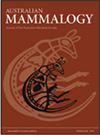睾酮抑制对雄性东灰袋鼠健康和寄生虫负担的影响
IF 1.2
4区 生物学
Q3 ZOOLOGY
引用次数: 0
摘要
睾酮在男性中有双重作用,以牺牲免疫防御为代价促进性装饰。这种权衡已经在几个分类群中得到了证明,例如雄性通常比雌性同类携带更大的寄生虫负担。我们使用一种新型促性腺激素释放激素(GnRH)疫苗Bopriva抑制野生雄性东方灰袋鼠(巨袋鼠)的睾丸激素10周。我们采用控制影响前-控制影响后(BACI)实验设计,评估了睾酮抑制对袋鼠睾丸宽度、健康参数、蜱虫负担的影响。考虑到动物运动对寄生虫负担的潜在影响,还确定了一个雄性亚群在核心区的使用情况。Bopriva显著降低雄性袋鼠的睾丸激素,并使睾丸总大小减少9.6% (P = 0.01)。与对照组(安慰剂)和治疗前的动物相比,睾酮抑制对治疗袋鼠的寄生虫负担和核心区域使用没有可检测到的影响。我们的研究结果表明,抑制时间可能需要超过10周才能观察到寄生虫负荷的变化。总的来说,本研究为未来研究生殖激素是否影响有袋动物的能量分配、寄生和生殖策略提供了一个合适的框架。本文章由计算机程序翻译,如有差异,请以英文原文为准。
The effect of testosterone suppression on health and parasite burden in male eastern grey kangaroos (Macropus giganteus)
Testosterone has a dualistic effect in males by promoting sexual ornamentation at the cost of immune defence. This trade-off has been demonstrated in several taxa, such that males often host a greater parasite burden compared with female conspecifics. We suppressed testosterone in wild male eastern grey kangaroos (Macropus giganteus) for 10 weeks using a novel gonadotropin-releasing hormone (GnRH) vaccine, Bopriva. We evaluated the impact of testosterone suppression on testes width, parameters of health, tick and worm burden in kangaroos using a before-after-control-impact (BACI) experimental design. Given the potential impact of animal movement on parasite burden, core area use of a subset of males was also determined. Bopriva significantly reduced testosterone in male kangaroos as well as reducing the combined size of testes by 9.6% (P = 0.01). There was no detectable effect of testosterone suppression on parasite burden and core area use in Treated kangaroos compared to Control (placebo) and Before treatment animals. Our results suggest that a duration of suppression longer than 10 weeks may be required to observe changes in parasite burden. Overall, this study provides a suitable framework for future studies to test whether reproductive hormones influence energy allocation, parasitism, and reproductive strategies in marsupials.
求助全文
通过发布文献求助,成功后即可免费获取论文全文。
去求助
来源期刊

Australian Mammalogy
ZOOLOGY-
CiteScore
2.50
自引率
8.30%
发文量
26
期刊介绍:
Australian Mammalogy is a major journal for the publication of research in all branches of mammalogy. The journal’s emphasis is on studies relating to Australasian mammals, both native and introduced, and includes marine mammals in the Antarctic region. Subject areas include, but are not limited to: anatomy, behaviour, developmental biology, ecology, evolution, genetics, molecular biology, parasites and diseases of mammals, physiology, reproductive biology, systematics and taxonomy.
Australian Mammalogy is for professional mammalogists, research scientists, resource managers, consulting ecologists, students and amateurs interested in any aspects of the biology and management of mammals.
Australian Mammalogy began publication in 1972 and is published on behalf of the Australian Mammal Society.
 求助内容:
求助内容: 应助结果提醒方式:
应助结果提醒方式:


